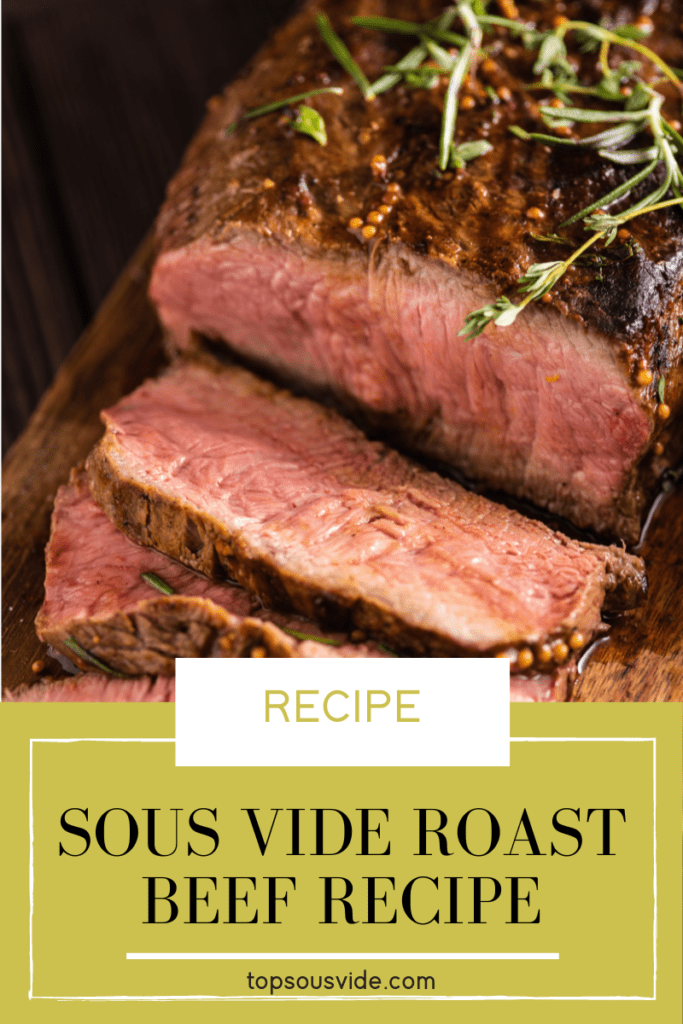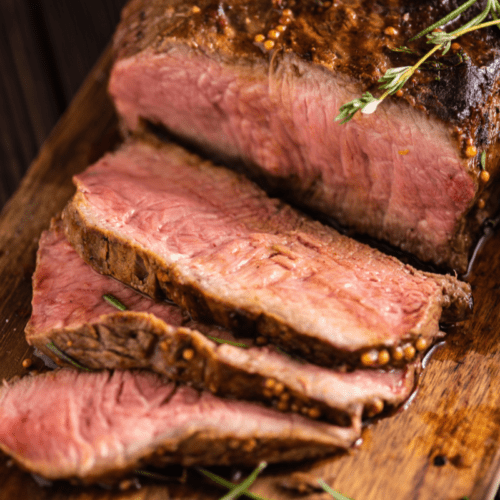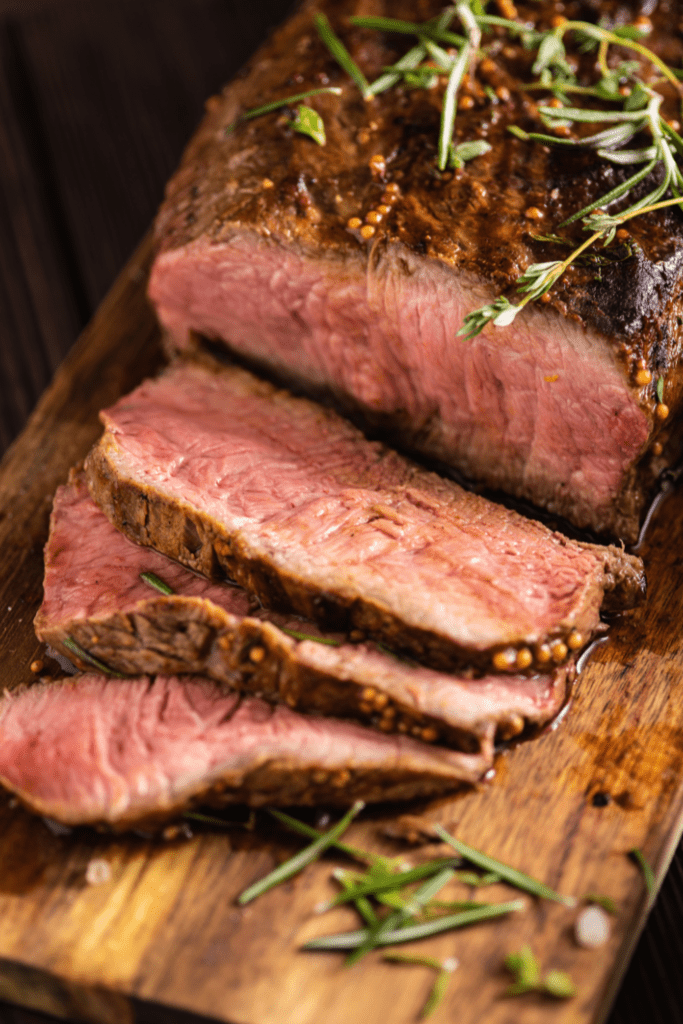Roast beef is a versatile dish that can be used as a center piece for both fancy and every night type dinners. Use leftovers for sandwiches, whether hot or cold. Cooking sous vide is a great way to prepare roast beef and make even the most economic cuts of beef tender, juicy and flavorful.
Furthermore, sous vide roast beef is the perfect meal to feed plenty of mouths when you don’t have a lot of time to spend hands-on cooking. All you need is a sous vide machine, a water bath, a searing pan and this simple recipe.
However, do note that though the recipe isn’t labor intensive, the meat does spend a significant amount of time in the water bath given you’re cooking a hunk of meat.

The basic steps are as follows: Set your sous vide cooker to the temperature and time in the recipe, place the beef in a vacuum sealed bag, and drop it in the water bath to cook. Next, pull it out when the time is up. Give it a sear all around for the last step and that’s it.
Below, we’ll explore a variety of topics on roast beef more fulsomely, but let’s go straight to the recipe sous vide first.
- Related article: Best Steak Cut for Sous Vide

Table of Contents
Sous Vide Roast Beef Recipe
Equipment
- Sous Vide Cooker
- Sous Vide Container
- Vacuum Sealer
- Vacuum Seal Bags
- Skillet
Ingredients
- 3 lb. beef cut hunk (e.g. chuck, eye of round, top round, tri-tip)
- 4 tbsp olive oil
- 3 sprigs fresh rosemary
- 6 garlic cloves
- 3 ounces butter
Instructions
- Set the sous vide cooker at 54.4°C / 130°F to preheat the water. This is the right temperature for beef to get that perfect pink center.
- Place the beef in the vacuum seal bag. Add the rosemary, garlic cloves and olive oil before sealing the bag.
- When the water reaches temperature, place the bag into the sous vide container. Cook for 21 hours +/-3.
- Once the beef has finished cooking, take it out of the vacuum sealed bag.
- Discard the liquid, and dry the meat down for a good sear.
- Pre-heat the cast-iron skillet at medium-high heat for 5+ minutes, melting the butter with about a minute left of the pre-heat.
- Place the roast beef on the hot skillet, searing in butter for 20-30 seconds per side until all sides are golden brown. If the desired sear hasn't been achieved after the first 30 seconds, repeat a 20-30 second sear AFTER searing the other sides.
- Season with salt as desired and it's ready to eat. No need for rest. Cut against the grain.
Notes
How to Choose the Best Cuts of Beef for Roast Beef
The sous vide cooking method is great for all types of cuts of beef. Starting off high on the tenderness spectrum, you can look at naturally tender cuts like ribeye and tenderloin.
You can also look at tougher beef cuts like eye of round, top round and top sirloin. Something like tri-tip falls in the middle of the spectrum. Sous vide works well with tenderizing all of the above. In other words, there’s no need to spend on the pricier cuts of meat which are naturally more tender.
The sous vide method is slow cooking at low temperatures, which results in tender, moist sous vide beef. Above all, there’s less room for error than when cooking on the grill, braising, or roasting in the oven.
As always, look for beef that has good marbling, to the extent applicable; That’ll help with the roast coming out more tender and juicy.
That said, choose your cut of beef based on what you’re preparing the meal for:
- Entertaining or nicer meals in general – seeking really tender meat as your main dish
- For everyday meals where budget is a practical consideration
- For deli cuts perfect for sandwiches
Entertaining Roast Beef Cuts
This class of cuts is naturally tender, rich, and superior to other cuts.
Ribeye
Ribeye is one of the most popular (and expensive) cuts due to its extreme natural tenderness given a high degree of marbling, which translates to tender and flavorful dishes. Dare I say king of roasts.

Beef Tenderloin
Lean yet delectable is the rare combination that makes beef tenderloin renowned. Red wine sauce is a staple pairing.

Prime Rib
Extremely tender and super juicy. Can’t be mentioned without au jus as an accompaniment. A classic entertainment cut sure to please.

Everyday Roast Cuts
These cuts will emulate the cuts above at a lower price point. The sous vide in particular does a nice job of upping the tenderness of this group. Versatility is a key attribute of these meats as they have a good mix of tenderness and beefiness.
Rump / Bottom Round / Top Round Roast
These are usually the least expensive and are popular cuts for home chefs roasting. A versatile cut, the rump roast pairs well with just about any side. Top round roast is commonly used for London Broil.

Shoulder Petite Tender
The affordable cousin of beef tenderloin; lean and flavorful.

Sirloin Roast
Sirloin is on the lean end of the spectrum and high on meaty flavor. I prefer the tri-tip portion (pictured below) of the sirloin for roasts; much of the rest of the sirloin lacks intramuscular fat and/or collagen.

Deli Cuts
Lean and dense cuts of even shape are what we’re looking for here. Large muscles allow for full slices.
Eye of Round
This is the quintessential deli cut. Lean and flavorful.

Sirloin Tip
Affordable and ideal shape, density, and leanness for slicing.

How to Sous Vide Roast Beef – Times and Temperatures
The sous vide roast beef recipe noted here uses 54.4°C / 130°F for 22 hours, which will get you a perfect medium-rare juicy roast. Add the sear on a skillet and that gives you an amazing seared crust and raises the internal temp ~5°F.
Certainly, time and temperatures can vary for roast beef due to different preferences with regard to doneness levels and texture desired. Different recipes’ cooking times can vary between 12 to 40 hours and temperatures between 130°F to 145°F.
The size of roast and cut of meat too will influence the length of time to roast sous vide. The tougher the meat, the longer you’ll want to sous vide the beef.
My experiences have resulted in my recommendation of 22 hours at 130°F, which will work well with a variety of cuts and sizes to roast.
At 130°F, the roasts become firm enough to slice. Cooking at lower temperatures resulted in the beef being too difficult to slice. Higher temperatures took away from the juicy-ness I desired with a perfectly pink center.

Sous Vide Roast Beef Time and Temperature Chart
Our recommended time is 22 hours at 130°F (54°C) for a ~3lb cut of beef. Keep in mind the sear will raise the internal temperature by a few degrees.
| Target Doneness | Temperature Range | Timing Range |
| Very rare to rare + | 120°F (49°C) to 129°F (54°C) | 12 hours |
| Medium-rare | 130°F (54°C) to 135°F (57°C) | 12 – 48 hours |
| Medium | 135°F (57°C) to 142°F (61°C) | 12 – 48 hours |
| Medium-well | 142°F (61°C) to 155°F (68°C) | 12 – 36 hours |
| Well done | 156°F (69°C) + | 12 – 24 hours |
Meanwhile, the cook didn’t seem particularly sensitive to the variable of time in terms of taste and tenderness. Plus or minus three hours to our base recommendation of 22 hours seems perfectly reasonable to me and assuredly safe. You can adjust up or down based on the size of your roast beyond the plus or minus three hours.
Where to Find Quality Roast Beef Cuts
Roast beef is generally from common cuts that can be found at your local butcher or grocery shop.
If you haven’t tried ordering online at Crowd Cow, I’d encourage you to do so. They have a large selection of high-quality meats and operate under the core tenents of taste, transparency and convenience.
Crowd Cow connects you to 100+ small farms across 23 states. The selection ranges from competitively priced grocery store staples to restaurant quality craft and heritage meats. Here’s a limited time coupon for $10 off your first Crowd Cow order.
How to Freeze Sous Vide Roast Beef
Sous vide allows you to cook a large amount of beef at one time and not worry about spoiling the meat, because you can freeze it.
If the roast is still hot or warm, cool the meat down completely. If you sous vide cooked beef as meal prep for the rest of the week, you can put the freshly cooked beef in an ice bath to cool it down.
Slice the cooled beef into multiple cuts, depending on how you plan to serve the roast beef. If you want sandwiches, slice it thinner. That’ll also help you with bagging and freezing the meat later, as well as thawing more quickly.
To seal the meat for the freezer, you can use the vacuum sealer (like those made by FoodSaver) again and that will keep the meat for a few months. Similarly, you can simply use Ziploc freezer bags and squeeze as much air out as you can when you seal the bags. Tightly wrapping the roast beef up in plastic wrap is another option.
How to Sous Vide Frozen Roast Beef
Thawing isn’t necessary with sous vide, but if you want, you can take out the frozen beef roast and put it in the refrigerator overnight to thaw.
With frozen roast beef, you can simultaneously thaw and reheat it with sous vide. Set the temperature and cook it for 40-60 minutes if thawed. Add 30 minutes if cooking from frozen.
I have an article on How to Sous Vide Frozen Steak if you’d like a deeper look.
Tasty Ways to Serve Roast Beef
There are many delicious ways to serve your perfectly cooked roast beef.
Away from a centerpiece roast of beef dish, one of my favorites is French dip sandwiches. The roast beef thinly sliced and put in a toasted French baguette as a sandwich with any toppings you want. Don’t forget the au jus!
In the same vein, Italian beef sandwiches are also a popular roast beef sandwich that’s full of roast beef flavor on bread with pickled vegetables for that tangy kick of flavor.
A salad is always a good complement to aid digestion when consuming a generous portion of meat.
Related Cooking Sous Vide Recipes
Check out these other sous vide recipes for more great food cooked sous vide:
- Try Sous Vide Carrots for a great side!
- Sous Vide Chuck Roast Recipe
- Sous Vide Filet Mignon Recipe
Roast Sous Vide FAQs
22 hours is our base recommendation. However, if you’re cooking a relatively small hunk of meat (vs our assumed 3 lbs.) and the cut of meat lacks intramuscular fat (e.g. Tenderloin), you could cook it in the 12-16 hour range.
As noted above, this comes down to the type of meal you intend to prepare. Seeking something special? A ribeye roast is hard to go wrong with. For an everyday versatile roast, we like tri-tip. For sandwiches, an eye of round or bottom round roast is a good choice.
Yes! Sous vide is a great way to prepare a roast, particularly those less expensive cuts that aren’t as naturally tender as the prime cuts of beef.
Cooking instructions are given above, but perhaps some practical realities lie in having a vacuum sealer and water container (e.g. a cooler) capable of handling the size of roast you plan to cook.
For long cooks, sous vide ping pong balls are a great option to lower water evaporation. Also, a higher power immersion cooker, such as the Anova Precision Cooker Pro, is handy for these situations.
Chuck roast can certainly be beef sous vide, but we find the collagen rich meat to be better used for stews and braises than roasts.
If you’re in the mood for an interesting short read, see The Colonel in the Kitchen: A Surprising History of Sous Vide.


Perfect roast beef to go on sandwiches
Thanks for sharing this roast beef recipe and all the others you have. This one turned out well.